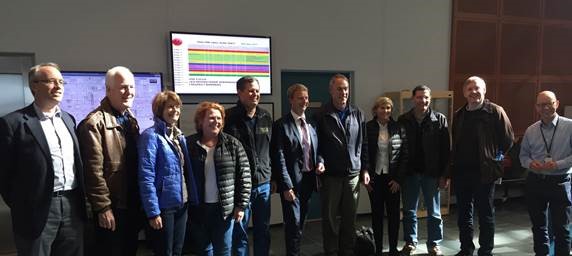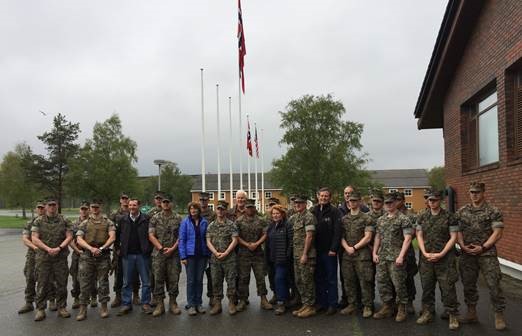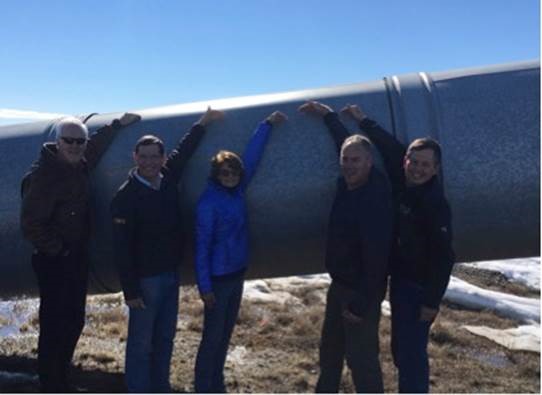Sen. Murkowski Leads Arctic Energy/Security CODEL
Interior Secretary and Five Senators Visit Norway, Greenland, and Alaska
U.S. Sen. Lisa Murkowski, R-Alaska, arrived in Fairbanks, Alaska, this weekend along with U.S. Secretary of the Interior Ryan Zinke and Sens. John Barrasso, R-Wyo., John Cornyn, R-Texas, Steve Daines, R-Mont., and Heidi Heitkamp, D-N.D. The delegation traveled to Norway, Greenland, and the North Slope of Alaska, with an itinerary full of meetings and site visits focused on Arctic energy and security.
“The best way to learn about the Arctic, to truly understand it and grasp its importance, is to come here and see it firsthand,” Murkowski said. “I thank my colleagues for making this trip—flying long hours to learn more about our opportunities for Arctic energy and to review the status of our defense capabilities in the region.”
The delegation’s first stop was Hammerfest, Norway, the site of the largest liquefied natural gas facility in Europe. The terminal’s operator, Statoil, plans to drill five of the 15 exploratory wells expected in the Barents Sea this summer. Hammerfest is located more than 600 miles above the Arctic Circle, at roughly the same latitude as Barrow, Alaska.

The delegation with Norwegian officials at the Snohvit LNG facility
The delegation also met with Norwegian officials to discuss the significant economic benefits the LNG facility and energy development have brought to local residents.
The following morning, the Secretary and Senators visited Vaernes Air Station to have breakfast with U.S. Marines deployed to Norway. The Marines arrived at Vaernes from Camp Lejeune, North Carolina, in January 2017 as part of the Marine Rotational Force-Europe. The force’s objective is to improve the Marines’ ability to fight in Arctic conditions and to strengthen partnerships with our NATO allies.

The delegation with members of the Marine Rotational Force-Europe
The delegation next traveled to Thule Air Base in northwest Greenland, roughly 750 miles above the Arctic Circle. Built on permafrost, the base features both a 10,000-foot long runway and a deepwater port. It is assigned to the Air Force Space Command.
“As we neared Memorial Day, when we remember those who have made the ultimate sacrifice, it was wonderful to spend time with the men and women who protect and defend our nation,” Murkowski said. “They’re far from home, in some very remote locations, but their missions are critical and we are very grateful for their service.”
The delegation then flew to Deadhorse, Alaska. At Pump Station 1 in Prudhoe Bay, the group received briefings from officials at Alyeska, the operator of the Trans-Alaska Pipeline System (TAPS), who explained how throughput in the line has fallen and the major operational challenges that creates. While the North Slope continues to hold prolific oil resources, access to federal lands and waters is severely limited, which is one of the key reasons that TAPS is now just one-quarter full.

“How full do you want TAPS to be?”
The Secretary and Senators next visited the CD-5 project in the National Petroleum Reserve-Alaska (NPR-A) to see the shrinking physical footprint of modern development on the North Slope. A project that would have taken up a 65-acre gravel pad in 1970 now requires a pad as small as 12 acres, and advances in extended reach directional drilling will soon increase the area accessible from those pads to 125 square miles—compared to just three square miles in 1970.
“When you visit new projects on the North Slope, you begin to understand not only how big Alaska is, but also how dramatically the footprint of development has decreased,” Murkowski said. “It’s almost hard to believe how little acreage is now needed to produce oil in Alaska.”
The delegation also flew an aerial tour over the North Slope and viewed the non-wilderness 1002 Area, a 1.5-million acre expanse within the 19-million acre Arctic National Wildlife Refuge that is projected to contain North America’s largest onshore conventional oil prospect.
“Ultimately, this codel affirmed that energy development is already occurring in the Arctic, that it can occur safely with the right protections in place, that it can provide real benefits for those who live near it, and that Alaska must be part of the picture,” Murkowski said. “I believe we also have greater awareness of the Arctic’s importance to our national defense, which will only grow as the region continues to open. I loved having the chance to spend time with our service members, and again thank my colleagues for making the trip to learn more about the Arctic.”
Murkowski is chairman of the Senate Committee on Energy and Natural Resources.








